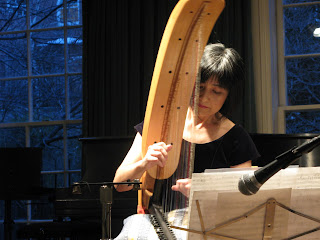琴兮 情兮 琴為何物 道者 心也 中道而已
關於我自己
網誌存檔
2009年8月4日 星期二
初訪嶗山
因為去青島大學音樂學院教授古琴 有機會來到中國北方唯一可達一千公尺的臨海高山---- 嶗山
光看這個[嶗]字就感覺此山多石 果然嶙峋如此 那是零五年冬 滿山結冰有雪
雖 然宋金時的王重陽與全真七子一路由終南山向東行 最後到了嶗山 建立了全真派叢林 但早在先秦時已有修行人在此修煉 秦始皇來此遇安期生 後命徐福東渡 漢武帝 唐玄宗都曾不遠千里來到此地訪道求仙 [華樓宮]建於元代泰定二年(公元一三二五年)由道士劉志堅創 其為七子中郝太古之徒弟 現由坤道冷道長主持 那日我拜訪該處與她見面一句說明身分 二句談到古琴 三句話還沒說完 她即叩頭拜師口稱師父 原來此道人早已知道他師父到了 我們結緣如此 忒也殊勝 此後每年至青島或居小住於此 或來山探望 飲一口[金液]泉水 對山石撫琴一曲
元時稱此處為[靈峰道院]長期以來甚多道士開鑿山洞 以為打坐修煉 其中我最喜打坐在[重陽洞]內 此洞僅夠一人容身 每透過矮松望著石門山夕陽 聽著喜鵲聲聲歸返夕澗竹林中 真意忘言
2009年8月2日 星期日
[兩卦流轉 古琴因緣]
[兩卦流轉 古琴因緣]
~~吳浸陽師祖所斲六十四卦琴
此二琴(如圖所見)是師祖 吳浸陽先生所斲於一九二五年間。當時他得到史量才先生支持,於上海一帶縣城中,覓得大量明代屋樑等優良木材,在申報館五樓琴室,設計監製了六十四床古琴,以易經六十四卦分別命名。
一九七三年夏,此二琴由 吳兆基恩師獲贈於其表舅母熊淑婉女史於上海。熊女史亦是吳浸陽之弟子,同年先生將其中一[鼎卦琴]贈於南京胞弟吳兆奇先生收藏至今,自珍藏[需卦琴]至一九九零年夏贈與余,其餘六十二床至今不知散佚何處。
浸陽師祖字觀月號純白。少年時出家青城山為道士,四川洪都人,長往於蘇州、上海、杭州一帶。民國八、九年間,供職於蘇州鹽公堂。堂主葉璋伯字希明,杭州人亦善操琴,需卦琴內刻文是其所題。葉先生亦是一九一九年八月怡園琴會之主持人,浸陽先生琴藝師承未詳,風格瀟洒靈活,兼具蜀、熟兩派之長。辛亥革命以後第一次全國性琴會,在一九二一年五月於上海晨風廬召開,由周夢坡先生主持。兆基恩師由其父吳蘭蓀領往,遇浸陽先生,獨衷其所奏漁歌、瀟湘,幾經周折得拜於門下,二年間恩師習得是二曲。三十年代初浸陽先生往香港未還,五十年代末歿於香港,身後蕭條。
二零零二年九月蘇州紀念吳蘭蓀一百二十誕辰音樂會中,余得緣見兆奇先生所藏之[鼎卦琴](如圖所見) 。琴聲沉洪清越、和潤含遠,與余所藏[需卦琴]一式一般,體樸形素,絕無近世作態氣息。
觀此二琴同為師祖所親斲,又兼傳其弟子,而[需卦琴]再傳與余,本門所重。薪燼火傳,元音新聲,意義深遠。[需卦琴]恩師曾戲稱為[扣子琴],問其故? 恩師言及,得琴時發現琴徽已失,當時無處得覓金玉螺鈿,乃親以衣扣磨而代之,至今仍在琴上完好。感兩代手澤融於一琴,觸物思往,念其間斯人、斯事,令人浩嘆。
二琴斲成至今已八十寒暑,幸均無恙,分處東西兩地,同響中外人間。特記此二琴之流轉因緣,以告諸同道。
癸未七月作於紐約
The Wanderings of Two I-Ching Guas
– A Story About Two Qins
The two qins were made in 1925, by the founder of my qin school, Wu Jinyang. At the time, he received support from Shi Liangcai and obtained a large number of Ming dynasty wood around cities near
In the summer of 1973, these two qins were given to my teacher Wu Zhaoji’s maternal aunt, Xiong Shuwan in
Wu Jinyang or Master Jinyang, also named Guanyue and Chunbai, left home to become a Daoist priest in his teenage years at
We do not know who Master Jinyang’s pedagogical ancestors were, but his style was elegant and lively. He possessed the best qualities of the
In the 1930’s, Master Jinyang went to
In September 2002,
These two qins are both created by Master Jinyang and henceforth, were inherited by his students. Xu gua qin was further passed down three generations by his student to me. In our school, we highly value these qins as they represent the school’s passage down generation after generation. Wu Zhaoji once joked that the Xu gua qin is really a “qin of buttons”. I questioned him about this correlation and he told me that the Xu gua qin lost all of its huis (markers) when he received it. So, he used buttons for the thirteen huis, after filing them down and gluing them onto the qin. To this day, the buttons still sits firmly on the qin.
As the qin and the buttons survive, the Xu gua qin is representative of two different people who belonged to two different generations. When I touch the qin, I think about its history, its relationships and its events. It truly makes one breathe a long sigh. It has been eighty years since the qin’s creation. The comforting fact is that the qin remains in good shape. It has lived in the East and the West, transmitted its music in
By Zhong Daoren, Yuan Jung-ping. August 2003,
豎琴與古琴的嘗試/箜篌的獨奏


箜篌早在《史記 封神書》記載:[於是塞南越 禱祠太一 后土 始用樂舞 益召歌兒 作二十五弦及箜篌琴瑟自此起] 箜篌有豎箜篌 臥箜篌 鳳首箜篌等 豎箜篌在漢代自西域已傳入中國 《 隋書 音樂志》記載:[ 今曲項琵琶 豎頭箜篌之徒 並出自西域 非華夏之樂器 ]
至遲自漢代始箜篌除可獨奏外 已與它種樂器以合奏形式出現 豎箜篌為西方豎琴的前身 因此在 2005年2月[紐約琴社]雅集時 於紐澤西New Brunswick與Rebecca Flannery 小姐合作嘗試一起演奏我所翻譯出 唐代手抄本文字譜[幽蘭]古曲 豎琴部分以伴奏為主時而齊奏 或獨奏某段樂句 琴則主奏全曲為主 是一次成功的演出
關於Rebecca Flannery:
http://www.newyorkqin.org/memberE.html#rebecca
 (左)Rebecca Flannery 小姐使用中型豎琴 (右)袁中平先生使用明代古木製無名蕉葉琴
(左)Rebecca Flannery 小姐使用中型豎琴 (右)袁中平先生使用明代古木製無名蕉葉琴後牆左方懸吳昌碩書法作品 右方為 先生(張隆延)作品[君亦]
此箜篌音量較之豎琴更微 音色卻較亮 餘韻比豎琴短 丁鏘之聲悅耳 相信是因為豎琴絃為尼龍所製 此箜篌絃為鋼絲所製 古代可能是用動物腸絃或絲絃所製 兩者在演奏手法上稍有不同 兼有古意 可遙想漢時風采 演奏者菅原曾多次尋求與琴合奏 目前時間尚未能配合
關於Tomoko Sugawara:
http://www.newyorkqin.org/memberE.html#tomoko

















